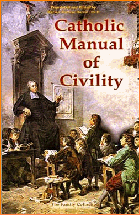What People are Commenting
Child Sex Abuse & Ambiguity: a Strategy
Ambiguity, a Strategy
Dear TIA,
Searching the Internet I found this reference to Mr. Guimarães’ book in the Murky Waters of Vatican II.
I am sure you will be glad to know of this new article based on one of your books.
Keep up the good work.
In Jesus through Mary,
R.K.
Modernists During Vatican II: Ambiguity Was a Strategy for Subversion
"The Council opened some doors. Other doors it left ajar because it saw the times were still not ripe." ~ Fr. Giovanni Caprile of La Civilta Catholica, Chronicler of VII.
EYEOFTHEPROPHETS
Ambiguity: The wedge for the progressive blade to return to its place and continue felling the tree of orthodoxy.
Ambiguity isn’t entirely understood when described as a compromise between conservatives and progressives.
Instead, as Atila Sinke Guimarães observed, “ambiguity […] obeyed strategic designs to facilitate handling the conservative reaction in the conciliar assembly, [while paving] the way for future and more explicit developments in the thought of the progressive current.”
Can we, however, prove these intentions? If so, the Hegelian Benedictine interpretation, the hermeneutic of continuity, and the like, shall be less tenable.
Fr. Edward Schillebeeckx, a modernist Dominican, testified that in the council, “a few intended to adopt formulas with double meaning so that the field would be open to the interpretation of ‘papal collegiality.’” In other words, cloudy phrases were a friendly gesture to the sensitivities of conservatives, with a backdoor to the progressive agenda.
Indeed, Cardinal Suenens appeared to agree with our analysis, asserting that “the texts are sometimes far richer in what they imply than in what they openly affirm.” Insinuation instead of proclamation, mistification instead of revelation, cloaking instead of showing.
This esoteric tendency in style certainly raises suspicion rather than confidence.
Yet, the ambiguous style, instead of raising strong concern, seemed to have sedated the conservative current. What occurred was that through ambiguity, Paul VI achieved unanimity concerning the texts.
Unanimity could not be achieved if the modernist tug for revolutionary formulations was too jarring; they might have awakened the dreaded opposition of the conservatives. “We could not go farther,” observed Fr. Yves Congar, “without causing ruptures.” As Msgr. Philips, the main writer of Lumen Gentium, lamented, “How difficult it is to satisfy even one’s own friends when in opposing fields!”
Still, such practices come at a cost.
Certain texts, noted Suenens, either “lose their point, or at least their forcefulness.” Indeed, when the subversive doctrines of the progressive current mingle with those of the conservative, confusion is wrought. And God is not the author of confusion, but clarity; anything else, as the Divine Master has counseled, is “from the devil.”
Nevertheless, to preserve this false unity, from which the progressive only stands to gain, Fr. Karl Rahner observed that unity was attained by the “tactic of leaving questions unsolved or by other means which, at first sight, may appear as an unfortunate compromise.” Of course, an “unfortunate compromise” with the conservative current.
Ideally, overt renovation was the modernist’s preference, rather than delays by obscure formulation. Delay, however, was ultimately preferred. After all, Suenens related them to “temporary stopping places on a long climb.”
As the Masons would say, “Never pronounce a word of impurity before them.”
So, ambiguity was not a saving grace for the conservative, as common opinion seems to hold, but a toxin for sedation and a shepherd’s cloak for subversion. Like the serpent, like the dove, the modernists have proved themselves wiser than the sons of light.
Source: In the Murky Waters of Vatican II by Atila Sinke Guimarães
Original here
Searching the Internet I found this reference to Mr. Guimarães’ book in the Murky Waters of Vatican II.
I am sure you will be glad to know of this new article based on one of your books.
Keep up the good work.
In Jesus through Mary,
R.K.
"The Council opened some doors. Other doors it left ajar because it saw the times were still not ripe." ~ Fr. Giovanni Caprile of La Civilta Catholica, Chronicler of VII.
EYEOFTHEPROPHETS
Ambiguity: The wedge for the progressive blade to return to its place and continue felling the tree of orthodoxy.
Ambiguity isn’t entirely understood when described as a compromise between conservatives and progressives.
Instead, as Atila Sinke Guimarães observed, “ambiguity […] obeyed strategic designs to facilitate handling the conservative reaction in the conciliar assembly, [while paving] the way for future and more explicit developments in the thought of the progressive current.”
Can we, however, prove these intentions? If so, the Hegelian Benedictine interpretation, the hermeneutic of continuity, and the like, shall be less tenable.
Fr. Edward Schillebeeckx, a modernist Dominican, testified that in the council, “a few intended to adopt formulas with double meaning so that the field would be open to the interpretation of ‘papal collegiality.’” In other words, cloudy phrases were a friendly gesture to the sensitivities of conservatives, with a backdoor to the progressive agenda.
Indeed, Cardinal Suenens appeared to agree with our analysis, asserting that “the texts are sometimes far richer in what they imply than in what they openly affirm.” Insinuation instead of proclamation, mistification instead of revelation, cloaking instead of showing.
This esoteric tendency in style certainly raises suspicion rather than confidence.
Yet, the ambiguous style, instead of raising strong concern, seemed to have sedated the conservative current. What occurred was that through ambiguity, Paul VI achieved unanimity concerning the texts.
Unanimity could not be achieved if the modernist tug for revolutionary formulations was too jarring; they might have awakened the dreaded opposition of the conservatives. “We could not go farther,” observed Fr. Yves Congar, “without causing ruptures.” As Msgr. Philips, the main writer of Lumen Gentium, lamented, “How difficult it is to satisfy even one’s own friends when in opposing fields!”
Still, such practices come at a cost.
Certain texts, noted Suenens, either “lose their point, or at least their forcefulness.” Indeed, when the subversive doctrines of the progressive current mingle with those of the conservative, confusion is wrought. And God is not the author of confusion, but clarity; anything else, as the Divine Master has counseled, is “from the devil.”
Nevertheless, to preserve this false unity, from which the progressive only stands to gain, Fr. Karl Rahner observed that unity was attained by the “tactic of leaving questions unsolved or by other means which, at first sight, may appear as an unfortunate compromise.” Of course, an “unfortunate compromise” with the conservative current.
Ideally, overt renovation was the modernist’s preference, rather than delays by obscure formulation. Delay, however, was ultimately preferred. After all, Suenens related them to “temporary stopping places on a long climb.”
As the Masons would say, “Never pronounce a word of impurity before them.”
So, ambiguity was not a saving grace for the conservative, as common opinion seems to hold, but a toxin for sedation and a shepherd’s cloak for subversion. Like the serpent, like the dove, the modernists have proved themselves wiser than the sons of light.
Source: In the Murky Waters of Vatican II by Atila Sinke Guimarães
Original here
Posted October 2, 2025

______________________
The opinions expressed in this section - What People Are Commenting - do not necessarily express those of TIA
______________________
______________________














Today’s entry topic!
Greetings to you! I have just started reading this and it's a tough one.
I am hoping you or a staff member or one of the great writers TIA usually have on board for articles has reviewed this title or perhaps would do so in the future.
.S.S.S.
Kieran Tapsell - Excerpt
For 1,500 years, the Catholic Church accepted that child sexual abuse was not only a sin but a civil crime, deserving of imprisonment and worse. From the 12th century onwards, seven Council and papal decrees required clergy who sexually abused children to be handed over to the civil authorities for punishment.
In 1917, the first Code of Canon Law abolished these papal and Council decrees. Then in 1922, Pope Pius XI issued his Instruction Crimen Sollicitationis imposing the strictest secrecy over allegations of child sexual abuse by clergy with no exceptions for reporting the allegations to the civil authorities. The punishment for breach of the secret was automatic excommunication from the Church, which could only be lifted by the pope personally.
The Church had revived by the use of secrecy the medieval privilege of clergy whereby they would only be tried in the canonical courts. If the State did not know about these crimes, there would be no prosecutions.
Five subsequent popes continued and expanded the cover up. Secrecy was not the only problem. The 1983 Code of Canon Law made it almost impossible for the Church to dismiss a priest child sex abuser without his consent. They were shifted around where they continued to abuse more children.
In 2017, the Australian Royal Commission into Institutional Responses to Child Sexual Abuse recommended the abolition of the pontifical secret over child sexual abuse and reforms to the dysfunctional disciplinary system.
In 2019, Pope Francis abolished the pontifical secret for child sexual abuse and made some changes to the disciplinary system. The Vatican has not acted on the Royal Commission’s recommendation that it publish its disciplinary judgments and the reasons for them in child sex abuse cases.
The pontifical secret has gone, but the Vatican is using the excuse of ‘office confidentiality’ to cover up abuse and avoid scrutiny of the Church’s disciplinary decisions.
This book is available here